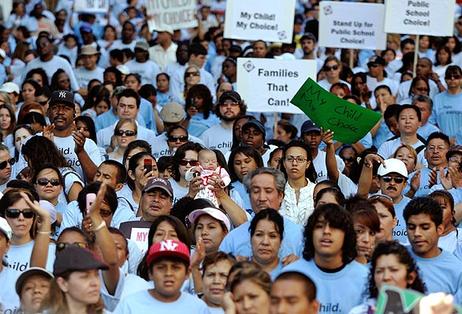What do you do with a school that consistently fails to maintain quality standards in educating students? Some school districts might opt to pull funding or close the school down completely. However, Los Angeles Unified School District has a very different idea in mind. This school district recently launched the Public School Choice reform, which allows other educational entities to take over failing schools in an effort to produce an institution that gets stellar results through innovation and autonomy.
Schools that do not make the grade each year are put on the eligibility list for Public School Choice reform. At that time, non-profits, teachers or charter operators can apply to revamp failing campuses. These entities can choose to operate completely separate from the school district, or they can work within district guidelines to produce a brand new educational system specifically geared to that school and the children who attend.
This year, according to MercuryNews.com, there are 26 existing schools and 17 new campuses that are eligible for Public School Choice Reform.
The Intercultural Development Research Association describes school choices as follows:
"In reality, school choice means very different things in different contexts. From the many versions of choice, we can construct three broad categories. First, there are choice programs within a single public school district. These local, “controlled choice” plans seek to expand educational options. Second, there are interdistrict and statewide public school plans. These seek to establish a public marketplace of schools through competition for enrollment. Third, there are voucher plans that include private schools. These seek to create an unrestricted marketplace of competing public, private, and parochial schools."
This video explains school choice.
Why Public Choice?
According to the LAUSD website, "The Public School Choice motion was designed to tap into the potential wealth of innovative ideas and educational models that will help the LAUSD advance its commitment to provide a quality education for our students."
The success of the program is dependent on participation by parents and the community. Individuals are encouraged to stay abreast of developments through the district website, giving them a say in how schools could be improved for the benefit of the students.
Public School Choice encourages other entities to bring innovation to the educational table. While many district policies and procedures might work perfectly at the majority of schools, others may find that the "cookie-cutter" approach to education just doesn't serve the special needs of the students on a particular campus. When others are allowed to run the school without worry over adherence to district policies, creativity and innovation are allowed to reign supreme, and the needs of the students can be the top priority in the process.
Benefits of Public School Choice
Advocates of Public School Choice have voiced many potential benefits from this program, including:
- Customized curriculum that addresses the specific needs of students in each school
- Innovation that moves well beyond standard ideas implemented by the school district
- Higher test scores at some of the charter schools that have been a part of the Public School Choice reform
- Longer school days and years for a more rigorous educational process overall
In a report from the Los Angeles Daily News, executive director of Granada Hills Charter, Brian Bauer, told prospective parents and students that while many schools in LAUSD were scaling back due to budget cuts, his school was actually increasing staff, services and salaries. Bauer also stated that Granada's test scores place this school at the top of the high schools in the LAUSD.
Camino Nuevo Chief Ana Ponce told Southern California Public Radio that her school customizes curriculum to a student body primarily made up of immigrant children. The lessons are bilingual, and lesson plans are tweaked annually to ensure students are enjoying maximum benefits from the curriculum. The school follows a longer school day and provides a rigorous assessment to ensure every child's progress in the school is carefully monitored.
This video reports on who opposes public school choice.
More Work to Do
One of the biggest proponents of Public School Choice is Los Angeles Mayor Antonio Villaraigosa. Mayor Villaraigosa wrote an op-ed for The Huffington Post over the summer, singing the praises of Public School Choice and expressing ideas on how the program could be improved. While Villaraigosa said that Public School Choice was critical for reforming schools in need, he added that improvements would be necessary to make the process more "rigorous, equitable and beneficial to the students in these schools."
Villaraigosa cited problems with the application process, and he stated that an effective reform-oriented program will be able to recognize when no qualified applicant is found. He added that applicants must be held to rigorous standards and judged on a proven track record. If the voting process is fair, unethical activity by applicants should not be tolerated, and those applications should be rejected immediately.
Villaraigosa is also dealing with a teachers' union that is opposed to the reform effort, due to concerns over "giving away" public schools to the highest bidder.
While the Public School Choice is not a perfect program, it is providing innovative solutions to many troubled schools today. As the program becomes more fair and equitable, everyone involved in the educational process should benefit, particularly the students who attend the schools under reform.
Questions? Contact us on Facebook. @publicschoolreview












